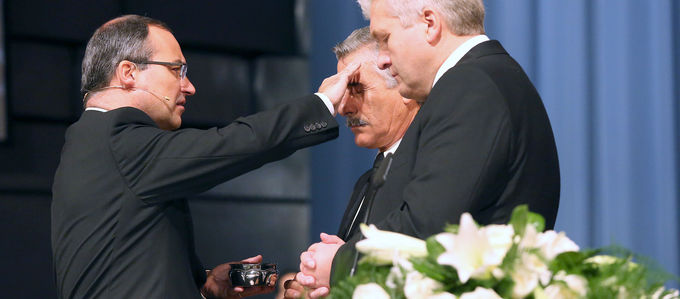
The Catholic practice of confirmation as a sacrament was only accorded a few quiet centuries. But then the reformers came along and sought to anchor the Christian rite of initiation in the act of baptism alone—and nevertheless instituted their own practice of confirmation in the process.
It is the sacrament that represents the completion of baptism and effects the “full outpouring of the Holy Spirit ”: this is how the Catechism of the Catholic Church defines confirmation (CCC 1302/1304). This has developed from a two-part riteof baptism with which early churches were already acquainted.
However, the reformers of the early sixteenth century had their problems with this kind of teaching—and there were at least three of them.
- On the one hand, the Protestants were unable to find any words of institution in the Bible by way of which Jesus would have instituted such a sacrament. The biblical evidence was limited to baptism and Holy Communion, for which the corresponding mandates from the Lord are recorded.
- On the other hand, the fact that the imparting of the Spirit was assigned to a completely different act served to devalue the sacrament of baptism in their view.
- Last but not least, they were bothered by the fact that confirmation was bound to the bishop ministry. This contradicted their doctrine of Universal Priesthood, also known as the Priesthood of all Believers.
Martin Luther was keen to insist on the latter in particular in his pamphlet “On the Babylonian captivity of the church”: “Indeed, if there were only such a thing in the church today as the laying on of hands as there was in the days of the Apostles!” he wrote in 1520. “But nothing of this has now remained, other than that which we ourselves have invented to expand the office of the bishops so that they are not entirely without work in the church.”
A compromise to the baptism dispute
Nevertheless, the reformers did end up inventing their own kind of confirmation. What does this have to do with the Catholic practice of confirmation? Well, in almost every language, the same word is used for both practices, and it derives from the Latin term confirmatio, which means “confirmation”, “reinforcement”, or “consolidation”.
And this invention came about as follows: as is so often the case with revolutions, the mainstream reformers still had some extreme fundamentalists on their back. In this case, they were known as the Anabaptists. This group rejected the idea of child baptism, and baptised adults anew because only the latter could make a conscious decision for Christ.
Martin Bucer, a leading Protestant reformer from Strasbourg, mediated the conflict between the Protestants and the Anabaptists: before partaking in Holy Communion for the first time, young believers were to learn the doctrine of the Church and then profess their faith before the congregation—as a retrospective yes to baptism. The evangelical act of confirmation was thus born.
An act of blessing in transition
But the reformed act of confirmation is no longer a sacrament, but rather an act of blessing, right? In terms of content, however, it was still very close to Catholic confirmation, at least initially. This is clear from the liturgical formula that Martin Bucer formulated in canonically binding fashion for the first time in the Ziegenhain Church Order of 1538/39: “Receive the Holy Spirit, the protection and shield from all evil, the strength and aid for all good…”
Over time, the emphasis shifted repeatedly: in the Pietist movement—one of the most significant reform movements within Protestantism—the focus turned to the confirmation vow starting in the seventeenth century. And in the eighteenth century, the theology of the Enlightenment emphasised the act’s character as a rite of passage from underage status to individual personal responsibility. And this left such a mark that even atheist states such as the German Democratic Republic needed a replacement in the form of its so-called youth inauguration.
Martin Bucer’s early reformatory concept of confirmation quickly found its way into the Book of Common Prayer, the liturgical book of the Anglican Churches in Great Britain. This mixture of Catholic and Protestant elements paved the way for a movement that came into being there in the nineteenth century, namely the Catholic Apostolic Church. This will be the focus of the next issue in this series.














